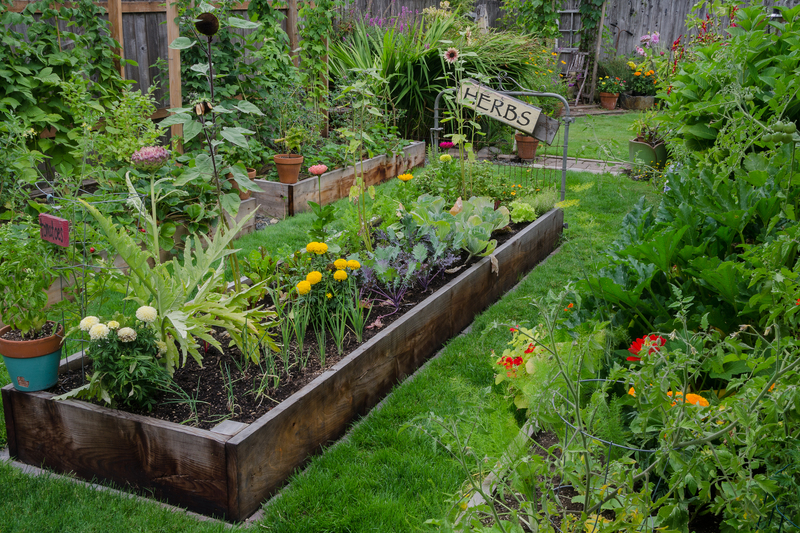Sustainable Living through Vertical Gardening
Posted on 20/06/2025
Introduction to Sustainable Living through Vertical Gardening
In our rapidly urbanizing world, the need for sustainable living practices has become more crucial than ever. Among the innovative solutions for modern dwellers with limited space is vertical gardening--a blossoming trend that offers a pathway to healthier, greener, and more self-sufficient lifestyles. This comprehensive article explores how sustainable living through vertical gardening is reshaping our cities, homes, and mindsets, aligning eco-friendly aspirations with practical methods to grow our own food, clean the air, and brighten our environments.

What Is Vertical Gardening?
Vertical gardening, sometimes referred to as vertical farming, involves cultivating plants upwards rather than outwards, utilizing vertical spaces like walls, trellises, shelves, and even stacked containers. This method is particularly useful in urban settings where ground space is at a premium, enabling city dwellers to enjoy gardening without a traditional backyard or garden plot.
Key Characteristics of Vertical Gardens
- Space efficiency: Ideal for apartments, balconies, rooftops, and small yards.
- Sustainable food production: Allows for the cultivation of edible plants, reducing reliance on commercially grown produce.
- Improved air quality: Living walls help filter toxins and improve local air conditions.
- Aesthetic value: Vertical gardens transform bland structures into vibrant, living landscapes.
The Connection Between Vertical Gardening and Sustainable Living
Sustainable living refers to adopting lifestyle choices and practices that reduce environmental impact while promoting wellbeing for current and future generations. Vertical gardening for sustainability sits at the heart of this movement, providing urbanites and rural residents alike with the means to grow food, beautify spaces, and create ecological habitats in areas once considered non-arable.
Benefits of Sustainable Vertical Gardening
- Reduces carbon footprint: Growing your own food minimizes transportation needs and packaging waste.
- Conserves water: Many vertical systems use drip irrigation and hydroponics, which are far more water-efficient than traditional gardening.
- Enhances biodiversity: Vertical gardens can attract pollinators like bees and butterflies, supporting local ecosystems.
- Promotes mental health: Contact with greenery and the act of gardening are known to decrease stress and boost happiness.
Getting Started with Vertical Gardening for Sustainable Living
Whether you're a seasoned horticulturist or a curious beginner, vertical gardening for sustainability can be tailored to all skill levels and space constraints. The following steps will guide you through establishing your own vertical garden at home:
Step 1: Choosing the Right Spot
- Assess sunlight: Most edible plants require at least 6 hours of sunlight daily. Choose a wall or space that receives appropriate light for your chosen plants.
- Evaluate accessibility: Make sure you can easily reach plants for watering and harvesting.
Step 2: Selecting Your Vertical Garden System
- Trellises and stakes: Ideal for climbing plants like beans, peas, and cucumbers.
- Hanging planters: Suitable for herbs, strawberries, and trailing flowers.
- Wall-mounted pockets and panels: Popular for living walls in both indoor and outdoor spaces.
- Stacked containers or shelves: Efficiently utilize vertical height and can be built from upcycled materials.
- Hydroponic towers: Soil-free systems that maximize yield in minimal space, perfect for urban sustainability.
Step 3: Choosing Plants for Sustainable Vertical Gardens
Select plants that thrive in your local climate and intended location. Here are some popular choices for vertical gardens:
- Edible varieties: Herbs (basil, mint, parsley), lettuce, swiss chard, spinach, cherry tomatoes, peppers, and strawberries.
- Ornamental plants: Ferns, succulents, pothos, philodendrons, and flowering vines like nasturtiums and morning glory.
- Pollinator-friendly options: Lavender, alyssum, marigolds, and salvia.
Step 4: Soil, Water, and Nutrient Management
- Use organic potting soil: Enriches plant health and supports eco conscious gardening.
- Implement water-saving techniques: Drip irrigation or self-watering setups enhance efficiency and sustainability.
- Organic fertilizers: Opt for compost or slow-release organic feed to minimize chemical runoff.
Tip: Regularly monitor your vertical garden for pests and diseases. When possible, use natural solutions such as neem oil or beneficial insects.
Innovative Vertical Gardening Ideas for Sustainable Living
Sustainable living through vertical gardening allows immense creativity. Here are some inspiring avenues to explore:
- Repurposed pallet garden: Use old wooden pallets as upright planters for herbs and greens--an eco-friendly and budget-conscious approach.
- DIY bottle wall: Recycle plastic bottles into a wall-mounted hydroponic garden.
- Hanging shoe organizer garden: Fill the pockets of a hanging organizer with soil and plants for a simple, modular vertical garden.
- Vertical food forests: In larger spaces, combine fruit trees, vines, and ground covers to mimic natural ecosystems.
- Green privacy screens: Use climbing plants on lattices or fences to create privacy while beautifying outdoor areas.
The Role of Technology in Vertical Gardens
- Automated irrigation: Smart watering systems reduce resource waste and ensure consistent moisture levels.
- App-controlled lighting: For indoor gardens, LED grow lights can be regulated for optimal plant development.
- Self-sustaining hydroponics: Recirculating systems lessen water usage and allow precise nutrient delivery.
Environmental Impact of Sustainable Vertical Gardening
Adopting sustainable living through vertical gardening brings numerous environmental benefits:
- Urban heat reduction: Green walls cool buildings, reducing reliance on air conditioning and lowering energy consumption.
- Stormwater management: Plants and growing mediums absorb rainwater and limit runoff, aiding urban water management.
- Waste upcycling: Integrating repurposed materials reduces landfill waste and supports a circular economy.
- Mitigating food deserts: Community vertical gardens provide fresh produce in underserved urban neighborhoods, promoting food justice alongside sustainability.
Case Studies: Vertical Gardening Making a Difference
- Singapore's Sustainable Skyscrapers: The city-state leads in integrating sky gardens and living walls into high-rise architecture, improving air quality and thermal comfort.
- Community Projects in Los Angeles: Urban garden collectives are transforming alleyways and parking lots with vertical farms, increasing green spaces and reducing grocery bills.
- Paris' Green Walls: The Musee du Quai Branly's lush exterior wall provides habitat for insects and birds, while capturing CO2 from city traffic.
Overcoming Challenges in Vertical Gardening for Sustainability
While the future is promising, vertical gardening for sustainable living does come with hurdles. Understanding these challenges--and how to navigate them--ensures lasting success:
- Upfront costs: Some vertical systems, especially high-tech hydroponic towers, may have higher initial investments. However, DIY alternatives using recycled materials offset expenses and environmental impact.
- Structural limitations: Not all walls can safely support heavy gardens. Always consult a professional if installing large or fully irrigated systems.
- Maintenance demands: Vertical gardens need regular care: pruning, feeding, and monitoring for pests. Starting with low-maintenance species can ease the learning curve.
- Water management: Overwatering or inadequate drainage may cause mold--opt for well-designed modular systems to control moisture.
Tips for Maximizing Your Sustainable Vertical Garden's Impact
- Combine edible and decorative plants: Mix leafy greens with flowering plants to maximize functionality and beauty.
- Rotate crops seasonally: Keep your garden productive by swapping out plants as the seasons change.
- Use natural pest control: Encourage beneficial insects or companion planting to keep pests at bay--chemical-free!
- Compost kitchen scraps: Feed your garden sustainably by returning organic waste to the soil.
- Involve the community: Shared rooftop or neighborhood gardens foster social ties and distribute benefits more widely.

Future Trends: The Evolution of Vertical Gardening and Urban Sustainability
The future of sustainable living through vertical gardening is vibrant, with innovators pushing the boundaries of what's possible:
- Integration into urban planning: City architects are increasingly incorporating green walls and roofs into building codes, promoting widespread adoption.
- Community-scale vertical farms: Advancements in hydroponics and aeroponics are making large-scale, high-yield urban farming a reality.
- Education and empowerment: Schools and nonprofits are teaching the next generation about sustainable agriculture, embedding green practices into everyday life.
- Pollinator corridors: Vertical gardens interspersed throughout cities create safe havens for critical pollinators in an otherwise inhospitable built environment.
Conclusion: Cultivating a Greener Tomorrow with Vertical Gardening
As cities grow denser and the need for sustainability mounts, adopting vertical gardening for sustainable living offers a solution that is practical, accessible, and environmentally profound. By harnessing vertical spaces, you can grow your own food, beautify your surroundings, and contribute to a healthier planet--all from the walls of your own home.
Whether it's a simple herb garden in your kitchen or a vibrant green wall on your balcony, every small step counts. Embrace the journey toward sustainability with vertical gardening and help transform our cities into greener, more livable spaces for all.
Start your sustainable living journey today by exploring vertical gardening--the possibilities are as boundless as your imagination!

